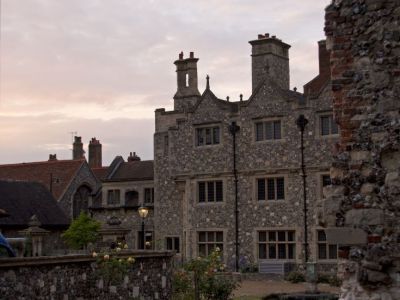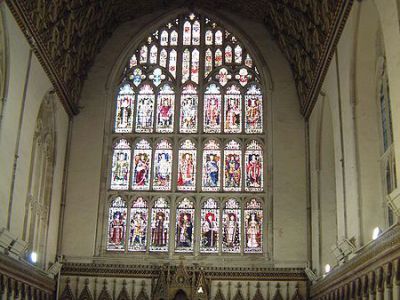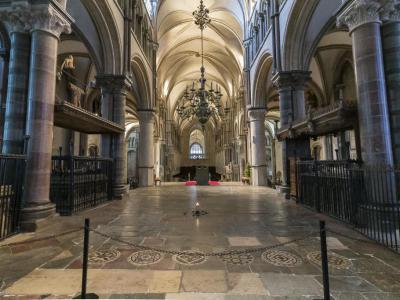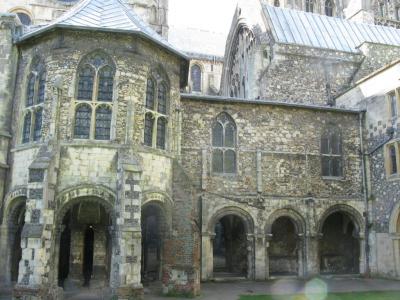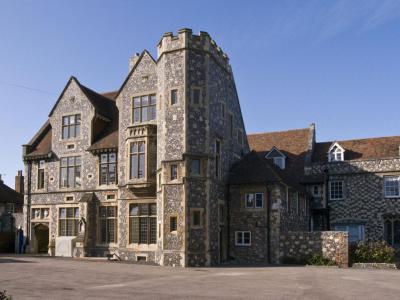
Canterbury Cathedral and Grounds (Self Guided), Canterbury
Canterbury Cathedral, one of the oldest churches that played a crucial role in English Christianity, stands within its own walled area, surrounded by Medieval buildings and ruins.
At the heart of this ensemble rises the cathedral itself, a magnificent example of medieval architecture and a UNESCO World Heritage Site. As you enter, you'll pass through the imposing Christ Church Gate, a grand entrance that sets the tone for the experience ahead.
Adjacent to the cathedral stands the Old Palace, a building steeped in centuries of ecclesiastical significance. The Cloisters, located on the north side of the cathedral, with their covered colonnade adorned with a grandiose domed roof, is a space for contemplation, reading, and writing, with ceiling knobs displaying the arms of those who contributed to the cathedral's construction and decoration.
Nearby, the Chapter House is a marvel of Gothic design, featuring magnificent medieval stained glass, a lofty timber roof, and stone seats, serving as a historic meeting place for monks and priests and later as a venue for sermons.
As you explore the grounds, you'll encounter landmarks such as the Water Tower, a testament to the cathedral's practical infrastructure, and the Healing Garden, a newly planted oasis, featuring ancient medicinal herbs cultivated for centuries and still utilized by modern herbalists.
Next to the garden is the prestigious King's School which has played a pivotal role in the educational landscape of Canterbury for centuries. The oldest structure in the Canterbury Cathedral precinct, the Norman Staircase, now stands as part of King's School, adjacent to the Memorial Court erected after World War I, serving as a memorial for those lost in both world wars.
Whether you're drawn to Canterbury Cathedral for its historical significance, architectural beauty, or spiritual resonance, a visit to this iconic site promises to be a memorable experience. So, take the opportunity to immerse yourself in centuries of tradition and heritage, and discover the timeless allure of Canterbury Cathedral and its grounds.
At the heart of this ensemble rises the cathedral itself, a magnificent example of medieval architecture and a UNESCO World Heritage Site. As you enter, you'll pass through the imposing Christ Church Gate, a grand entrance that sets the tone for the experience ahead.
Adjacent to the cathedral stands the Old Palace, a building steeped in centuries of ecclesiastical significance. The Cloisters, located on the north side of the cathedral, with their covered colonnade adorned with a grandiose domed roof, is a space for contemplation, reading, and writing, with ceiling knobs displaying the arms of those who contributed to the cathedral's construction and decoration.
Nearby, the Chapter House is a marvel of Gothic design, featuring magnificent medieval stained glass, a lofty timber roof, and stone seats, serving as a historic meeting place for monks and priests and later as a venue for sermons.
As you explore the grounds, you'll encounter landmarks such as the Water Tower, a testament to the cathedral's practical infrastructure, and the Healing Garden, a newly planted oasis, featuring ancient medicinal herbs cultivated for centuries and still utilized by modern herbalists.
Next to the garden is the prestigious King's School which has played a pivotal role in the educational landscape of Canterbury for centuries. The oldest structure in the Canterbury Cathedral precinct, the Norman Staircase, now stands as part of King's School, adjacent to the Memorial Court erected after World War I, serving as a memorial for those lost in both world wars.
Whether you're drawn to Canterbury Cathedral for its historical significance, architectural beauty, or spiritual resonance, a visit to this iconic site promises to be a memorable experience. So, take the opportunity to immerse yourself in centuries of tradition and heritage, and discover the timeless allure of Canterbury Cathedral and its grounds.
How it works: Download the app "GPSmyCity: Walks in 1K+ Cities" from Apple App Store or Google Play Store to your mobile phone or tablet. The app turns your mobile device into a personal tour guide and its built-in GPS navigation functions guide you from one tour stop to next. The app works offline, so no data plan is needed when traveling abroad.
Canterbury Cathedral and Grounds Map
Guide Name: Canterbury Cathedral and Grounds
Guide Location: England » Canterbury (See other walking tours in Canterbury)
Guide Type: Self-guided Walking Tour (Sightseeing)
# of Attractions: 10
Tour Duration: 1 Hour(s)
Travel Distance: 0.8 Km or 0.5 Miles
Author: Sandra
Sight(s) Featured in This Guide:
Guide Location: England » Canterbury (See other walking tours in Canterbury)
Guide Type: Self-guided Walking Tour (Sightseeing)
# of Attractions: 10
Tour Duration: 1 Hour(s)
Travel Distance: 0.8 Km or 0.5 Miles
Author: Sandra
Sight(s) Featured in This Guide:
- Christ Church Gate
- Old Palace
- The Cloisters
- Chapter House
- Canterbury Cathedral
- Trinity Chapel at Canterbury Cathedral
- The Water Tower
- Healing Garden
- King's School
- Norman Staircase & Memorial court
1) Christ Church Gate
The primary route to Canterbury Cathedral passes through the ornate Gothic Christ Church Gate. Entrance to the rest of the Cathedral is through an adjoining guest information center and shop.
Like the rest of the Cathedral, the Gate has been repaired and restored numerous times.
The Gate suffered damage and the main statue was destroyed during the English Civil War in 1643. The statue was not replaced until 1990, even though the rest of the Gate was restored in 1660. In 1803 the original towers were removed but were replaced in 1937.
Over the past few years, there have been ongoing preservation and restoration efforts on the Gate and the rest of the Cathedral.
Like the rest of the Cathedral, the Gate has been repaired and restored numerous times.
The Gate suffered damage and the main statue was destroyed during the English Civil War in 1643. The statue was not replaced until 1990, even though the rest of the Gate was restored in 1660. In 1803 the original towers were removed but were replaced in 1937.
Over the past few years, there have been ongoing preservation and restoration efforts on the Gate and the rest of the Cathedral.
2) Old Palace
The Old Palace belongs to the precincts of the Canterbury Cathedral. It dates from the 11th century. The palace served as residence for many archbishops and it still remains. The building once housed The Parliament, since 1647, during the English Civil War. Then it got the previous status of the Bishop’s Palace and was rebuilt at the end of the 19th century. Archbishop's Palace underwent many alterations and adjustments in the course of time. It was reopened again in 2006 after a two-year process of much needed refurbishment.
3) The Cloisters
The Cloisters are situated on the north side of the Canterbury Cathedral. It is a covered colonnade that encloses small square courtyards attached to the side of the Cathedral. The structure dates from the 14th century; it was planned and built in around 1400 by a Kentish Man, Stephen Lote. The highlight of the cloisters is the grandiose domed roof decorated with many painted shields and figures. The walkway served as a place for contemplation as well as for reading and writing. On the ceiling of the Cloisters are knobs that bear the arms of persons who have contributed money to the building and decoration of the Cathedral.
4) Chapter House
The Chapter House and the Cloisters are situated on the north side of the Canterbury Cathedral. This magnificent chamber inside a separate building is the largest chapter house in England. The Chapter House was built in the late 14th century. The central zone of the chapter house is an open space. The Chamber House interior features the wonderful Medieval stained glass, lofty timber roof, and stone seats ring the walls under arched stone niches and Prior’s noble seat. It was the meeting place for monks and priests who represented the council and prayed. Later, sermons were preached here. It's worth trying to get inside.
5) Canterbury Cathedral (must see)
The formal name of the Canterbury Cathedral is the Cathedral and Metropolitical Church of Christ at Canterbury. It is one of the oldest and most well-known Christian structures in all of England and it is a World Heritage Site.
It was originally founded in 597 and has been expanded and rebuilt many times in its history.
In its earliest days, the church was part of a Benedictine monastic community and was the seat of the archbishop. The first bishop was Augustine of Canterbury, a missionary sent in 596 by Pope Gregory I. He also founded Saint Augustine's Abbey, though it was not called that then, located outside the city walls.
The building as it is now was more or less laid out by Archbishop Lanfranc and dedicated in 1077 after the Norman Conquest. It was built from stone from France and designed to be like the Abbey of Saint-Étienne in Caen.
A pivotal moment in the Cathedral's history was the murder of Archbishop Thomas Becket. Becket was murdered in the northwest transept in 1170 by knights of King Henry II. The events transformed the Cathedral into a place of pilgrimage. Such pilgrims were depicted in Chaucer's Canterbury Tales.
Today the Archbishop of Canterbury serves as the global leader for the Anglican Communion and leader of the Church of England.
Why You Should Visit:
The Cathedral is a World Heritage Site and one of the most stunning examples of Gothic architecture in England.
Tips:
Plan to dedicate at least three hours to tour the Cathedral. GPSmyCity offers a self-guided tour to help you explore the Cathedral and its grounds.
Be sure to look up! Some of the most impressive examples of architecture lie in the fan vaulting, ornate carvings, and beautiful stained glassworks.
It was originally founded in 597 and has been expanded and rebuilt many times in its history.
In its earliest days, the church was part of a Benedictine monastic community and was the seat of the archbishop. The first bishop was Augustine of Canterbury, a missionary sent in 596 by Pope Gregory I. He also founded Saint Augustine's Abbey, though it was not called that then, located outside the city walls.
The building as it is now was more or less laid out by Archbishop Lanfranc and dedicated in 1077 after the Norman Conquest. It was built from stone from France and designed to be like the Abbey of Saint-Étienne in Caen.
A pivotal moment in the Cathedral's history was the murder of Archbishop Thomas Becket. Becket was murdered in the northwest transept in 1170 by knights of King Henry II. The events transformed the Cathedral into a place of pilgrimage. Such pilgrims were depicted in Chaucer's Canterbury Tales.
Today the Archbishop of Canterbury serves as the global leader for the Anglican Communion and leader of the Church of England.
Why You Should Visit:
The Cathedral is a World Heritage Site and one of the most stunning examples of Gothic architecture in England.
Tips:
Plan to dedicate at least three hours to tour the Cathedral. GPSmyCity offers a self-guided tour to help you explore the Cathedral and its grounds.
Be sure to look up! Some of the most impressive examples of architecture lie in the fan vaulting, ornate carvings, and beautiful stained glassworks.
6) Trinity Chapel at Canterbury Cathedral
Trinity Chapel is located at the east end of Canterbury Cathedral. It was completed in 1184 as a shrine for Saint Thomas Becket's relics. This site became a popular pilgrimage site.
The chapel replaces a smaller chapel that burned down in 1174. Thomas Becket had celebrated his first mass as Archbishop of Canterbury in the smaller chapel. After the archbishop of York crowned Henry the Young King, Becket excommunicated the archbishop of York and two other church leaders. Henry expressed his displeasure, and knights killed Thomas Becket in the Canterbury Cathedral.
The popularity of the pilgrimage site inspired Geoffrey Chaucer to write Canterbury Tales in 1387. In 1540, King Henry VIII had Becket's shrine and bones destroyed. Today, visitors will find a lighted candle marking the former site of Becket's shrine.
Edward Plantagenet, the Black Prince, is entombed in this chapel. King Henry IV and his consort, Joan of Navarre, are buried in Trinity Chapel. While most kings are buried in Westminster Abbey, King Henry IV wanted to be connected with Thomas Becket. There are alabaster effigies of the King and Queen on top of the tomb.
The Corona Tower is at the east end of Trinity Chapel. Also called Becket's Crown, this area housed some of Becket's relics. It also housed Saint Odo's and Saint Wilfred's shrines.
The chapel replaces a smaller chapel that burned down in 1174. Thomas Becket had celebrated his first mass as Archbishop of Canterbury in the smaller chapel. After the archbishop of York crowned Henry the Young King, Becket excommunicated the archbishop of York and two other church leaders. Henry expressed his displeasure, and knights killed Thomas Becket in the Canterbury Cathedral.
The popularity of the pilgrimage site inspired Geoffrey Chaucer to write Canterbury Tales in 1387. In 1540, King Henry VIII had Becket's shrine and bones destroyed. Today, visitors will find a lighted candle marking the former site of Becket's shrine.
Edward Plantagenet, the Black Prince, is entombed in this chapel. King Henry IV and his consort, Joan of Navarre, are buried in Trinity Chapel. While most kings are buried in Westminster Abbey, King Henry IV wanted to be connected with Thomas Becket. There are alabaster effigies of the King and Queen on top of the tomb.
The Corona Tower is at the east end of Trinity Chapel. Also called Becket's Crown, this area housed some of Becket's relics. It also housed Saint Odo's and Saint Wilfred's shrines.
7) The Water Tower
The Water Tower is an octagonal tower adjacent to to the Cathedral building on the north side, behind the cloisters. This Romanesque tower is supported by a series of interwoven arches that look quite artistic. It was crafted by the order of Prior Wilbert to get a clean water supply to the priory buildings. The Water Tower dates back to the 12th century or earlier. Part of its piping survives and is functioning today. There is a large basin and a fountain in the center of the tower for washing.
8) Healing Garden
This is a new planted garden, also named Herbarium, on the site of the Medieval monk's dormitory adjacent to the original Monastic Herbarium. Healing Garden is part of the Cathedral Gardens and comprises a large Deanery garden, small orchard, rare Medlar tree and a herbaceous and vegetable garden. Enclosed on three sides, Healing Garden is planted with herbs that have been used for thousands of years and had been used by the first Monks for healing purposes. Most of these herbs are used by modern day herbalists.
9) King's School
The King's School is a British co-educational independent school for both day and boarding pupils in the historic English cathedral city of Canterbury in Kent. It is a member of the Headmasters' and Headmistresses' Conference and the Eton Group.
The school originated as a medieval cathedral school, and it is often claimed to have been founded in AD 597 by St. Augustine, therefore making it the world's oldest extant school. This is based on the fact that St. Augustine founded an abbey (within the current school's grounds) where it is known that teaching took place. When the dissolution of the monasteries occurred in the reign of Henry VIII, the school was refounded as The King's School, Canterbury.
The school originated as a medieval cathedral school, and it is often claimed to have been founded in AD 597 by St. Augustine, therefore making it the world's oldest extant school. This is based on the fact that St. Augustine founded an abbey (within the current school's grounds) where it is known that teaching took place. When the dissolution of the monasteries occurred in the reign of Henry VIII, the school was refounded as The King's School, Canterbury.
Sight description based on Wikipedia.
10) Norman Staircase & Memorial court
At the north corner of the Green Court is the oldest structure in the Cathedral precinct. It is a covered staircase from 1100 built by the Normans along with the vast rebuilding of the buildings in the Cathedral close. The staircase is the part of the Poor Pilgrim's Hall that served as a shelter for pilgrims. The entrance and parts of the North Wall remained from that building. Today it’s part of the King's School. Near the Norman Staircase is The Memorial Court with an octagonal shaft on the base topped with the cross. It was erected after World War I. Now it serves as a memorial of those who died during the World Wars.
Walking Tours in Canterbury, England
Create Your Own Walk in Canterbury
Creating your own self-guided walk in Canterbury is easy and fun. Choose the city attractions that you want to see and a walk route map will be created just for you. You can even set your hotel as the start point of the walk.
Canterbury Introduction Walking Tour
Canterbury is a UNESCO World Heritage City and one of the most visited cities in England. Canterbury has a long history and has been occupied since Paleolithic times. It was the capital of the Celtic Cantiaci, Romans settled the area for centuries, and the site was the capital of the Kingdom of Kent.
Saint Augustine arrived in Canterbury in 597 to convert the Anglo-Saxons to Christianity. The... view more
Tour Duration: 2 Hour(s)
Travel Distance: 2.7 Km or 1.7 Miles
Saint Augustine arrived in Canterbury in 597 to convert the Anglo-Saxons to Christianity. The... view more
Tour Duration: 2 Hour(s)
Travel Distance: 2.7 Km or 1.7 Miles
The Most Popular Cities
/ view all

